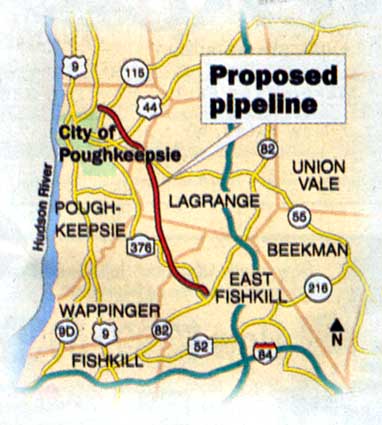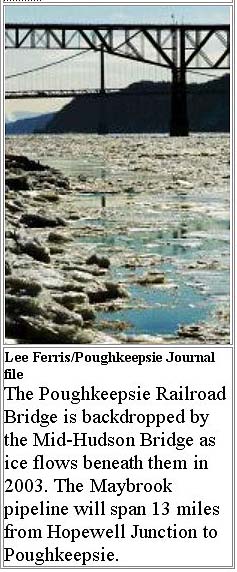
February 23, 2005
VALLEY DEVELOPMENT MAYBROOK LINE
Pipeline could guide growth
Construction is set to start this spring
By Dan Shapley
Poughkeepsie Journal

VALLEY DEVELOPMENT MAYBROOK LINE
Pipeline could guide growth
Construction is set to start this spring
By Dan Shapley
Poughkeepsie Journal

HOPEWELL JUNCTION -- The Central Dutchess Water Pipeline may be used to supply water to new and existing communities in East Fishkill, and help preserve groundwater in one of the county's most important aquifers.
And it could provide a second supply of water for the Town of Wappinger, where the need for a backup supply was emphasized last year when a gasoline tanker truck overturned and spilled near the town's wells.
But officials from the two other towns along the pipeline's route -- Poughkeepsie and LaGrange -- said they don't expect the water to supply any current residential communities or future development.
Construction is to begin this spring on the 13-mile pipeline, which will follow the old Maybrook rail line from Poughkeepsie to East Fishkill. The $33.25 million cost will be split primarily between IBM Corp., the state and county. East Fishkill taxpayers' share is $269,000.
IBM plans to use 2 million gallons of water per day from the pipeline. The pipes will have a capacity of 10 million gallons per day, but the Poughkeepsie water treatment plant currently has the capacity to supply it with only 4.25 million gallons per day.
Biggest project of its kind in county

Touted as the largest infrastructure project in the county's history, county officials have said it will not only anchor the region's largest employer to East Fishkill and allow for IBM's expansion, but also allow towns along its route to plan for "smart growth."
"For the communities along the pipeline, if they have groundwater pollution problems, or a shortage of water, or for future development along that corridor, they have a secure supply of water," said Thomas LeGrand, chairman of the Dutchess County Water and Wastewater Authority, which will build, own and operate the pipeline.
It doesn't appear that water from the pipeline will have a big effect on future development, at least not in the near future, according to interviews with town officials. Neither will it immediately attract sprawling new development to untouched forests or farmland, as some critics have said it might.
In East Fishkill, the pipeline could supply water to three developments in and around Hopewell Junction -- the Hopewell Glen, Lake Walton Park and Twin Creeks developments, town planner John Morabito said. He said no other open land in East Fishkill that could be developed lies along the pipeline's route.
All three projects are still under review. Together, plans call for 630 new houses and townhouses on about 500 acres.
"At this point, we are still in the early planning stages for the development, so the discussions are all pretty hypothetical. We think tying in would be a great thing. It's a matter of timing," said Joel Rea, a spokeswoman for PRM Realty of Chicago, which plans to build Lake Walton Park.
The other two developers -- Toll Brothers of Pennsylvania and Thylan Associates of New York City and Fishkill -- did not return phone calls.
The developers' plans already called for supplying central water to their subdivisions with new community wells. The three developments will also be part of a Hopewell Junction sewer district that, when built, will discharge treated waste to the Fishkill Creek.

The central water and sewer infrastructure will allow developers to cluster buildings closer together, preserving some outlying open space, Morabito said. That's a central tenet of "smart growth," which seeks to balance development with environmental protection and preservation of a community's character and resources.
Because the developers already planned to supply water from community wells, however, the size and layout of the subdivisions are unlikely to be affected by the availability of water from the pipeline.
Using Hudson River water instead of well water would, however, allay concerns about depleting groundwater in neighbor's wells, Morabito said. Instead of pumping water from the ground and discharging it to the creek, which empties into the Hudson, the water will come from and be returned to the Hudson.
East Fishkill resident Joseph Cavaliere agreed. The amount of new building in town troubles him, and he said new developments should conserve as much open space as possible. Since new developments often opt to provide central water in order to build more homes, piping it in from the Hudson is preferable to digging new wells, he said.
"You can only take so much from the wells. I look at the pipeline as a good thing to do, to be sure there's more water around," he said.
Bert Glassberg, however, sees the pipeline as promoting more growth in East Fishkill than the school system, local roads or the taxpayers can handle.
"If the pipeline goes through there, then that area will be developed," he said. "Yet another development. Already they're talking about the need for new schools."
Impact may grow
The pipeline's usefulness and impact may grow in the future. The town has plans to connect various small water supplies in and around Hopewell Junction, and there are early discussions about expanding the water district, Morabito said.
Having central water is attractive to developers. It allows them to build more homes on less land, and often satisfy a community's desire to preserve some open space or create more affordable housing, said Mario Johnson, a spokesman for the Hudson Valley Builders Association.
"It's a big draw, definitely. If we had more opportunities like that," Johnson said about the Central Dutchess Water Pipeline, "it would lend itself to better planned developments."
Critics of the pipeline had worried the availability of water would bring with it a rush of development through the center of the county, creating traffic and consuming open space.
"This will have a major impact on the town development, imposed on them by the county. There are lots of issues still out there, and I think people are just ignoring them as if they're not going to be a big deal," said Roy Budnik, a Town of Poughkeepsie resident and environmental consultant. "Anything that encourages development outside of our already developed areas is encouraging sprawl."
Town officials in Poughkeepsie, LaGrange and Wappinger, however, said the pipeline will not pass through undeveloped areas, and that water from the pipeline will have little or no effect on development.
In Wappinger, the water can be used as a backup supply -- if it is affordable, Supervisor Joseph Ruggerio said.
It also might supply water to one industrial area of town, Hackensack Heights near the Dutchess County Airport, where businesses like Southeast Container now use groundwater. It could help the town attract more business, Ruggerio said.
"Infrastructure is always a major asset when you're trying to recruit employers," he said.
Town water systems already pipe water to other areas through which the pipeline will pass, according to town officials in Wappinger, LaGrange and Poughkeepsie.
"I'd be more concerned if this pipeline was in the eastern portion of the town, where we have low- density zoning. There might then be some pressure to open that area to more development, or higher density development," LaGrange Director of Planning and Zoning Joachim Ansorge said. "But considering that it basically runs through the southwest portion of the town, that's the area that we had designated for higher density zoning to begin with. It really shouldn't change the character."
Even if the towns don't have immediate use for the water, the infrastructure could be important in the future, said Joan Pagones, president of the Association of Dutchess County Mayors and Supervisors. As supervisor of Fishkill, she said her town stands nothing to benefit immediately, but could far in the future. Lines can be built branching from the main line if capacity is available from the Poughkeepsie water treatment plant.
"The possibility will always be there to benefit by it," Pagones said.
| Watershed Home | Media Menu |